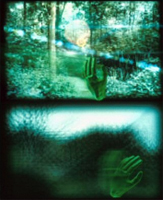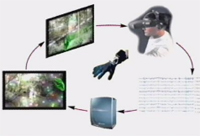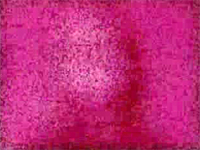May 19, 2007
404 FESTIVAL - ON TOUR / EUROPE 2007

Einstein's Brain Project
[left: Alan Dunning, Paul Woodrow, The Einstein's Brain Project: The Errant Eye, 1997-2001. Virtual reality installation. The participant navigates around a recognizable visual environment, a forest whose outline faded into an abstract visual universe reflecting the variations in biological signals processed in real time by a computer module.]
Astas Romas & 404 Festival decided to launch a European Tour that begins on May 31, 2007. Directors and team of the "404 Festival" will be visiting cultural centers, public and alternative places performing live concerts, projections and conferences, also presenting "404 selected" artworks from international authors. Artists from different countries will join this tour, such as SadMb (Japan), Synchdub (Belgium), Sample Mousse (Finland), Guillermo Giampietro & Lara Baracetti (Italy), Einstein's Brain Project (Canada), Vladimir Manovski and Aleksandar Secerov (Serbia), Miha Ciglar (Slovenia), among others.
"...The cycle of installations in The Einstein's Brain Project (1995-2001) is a major technological detour for Dunning that, nonetheless, re-examines his past conceptual concerns. In this long-term project begun in 1995 with Paul Woodrow and a team of scientists from different fields, Dunning probes the new epistemological models that have developed thanks to technological advances in virtual reality.
The artificial worlds summoned up by the immersive universes often rekindle the presuppositions of a naturalistic project whose aim is to simulate familiar experiences. The interfaces created by Dunning and Woodrow propose a critical counterbalance to the withdrawal to the Cartesian universe. In the wake of recent research in cognitive science, the two men are interested in how biological and brain processes shape our perception of the world.

[Left: Diagram showing the way biological data gathered in real time on the participant's body is altering the display parameters of a three-dimensional virtual universe.] An initial series of installations completed between 1997 and 2001 explored popular culture's fascination with the human brain. Evidence of this fascination is found in Roland Barthes's essay on the fetishism of Einstein's brain, a reflection that serves as a critical point of reference for the installations in this body of work. By reactivating obsolete systems of representation (phrenology, eugenics, etc.), this series also underlines the impact of pseudo-scientific projections on our knowledge of the body and psyche.
In The Fall, The Furnace, The Flesh (1997), (7) participants underwent a sort of ritual as they crossed through a curtain made up of thin vinyl strips. These strips served as a screen for projecting an image of a blazing fire. Participants found themselves in a cubic space defined by four screens. In the middle of the space was an anatomically correct model of the human head covered with touch-sensitive pads (audio-digital). The location of the 55 pads replicated the brain map developed by the phrenologists Franz Joseph Gall and Johann Spurzheim. In the Victorian age, studying the skull's contours over these zones supposedly revealed a person's character traits and psychological predispositions. Dunning recycled the paradigm of phrenology as a means of accessing the installation's touch-sensitive interface. As participants pressed the pads, a series of video segments were projected on the wall. These segments, which came from various sources, showed irreconcilable objects and events that evoked the series of random associations produced by the brain as it assembles fragments of stored memory. Here, the unconscious content could not easily be distinguished from fragments of images from the media sphere. Images appeared erratically: a lunar eclipse, close-ups of the body, a political demonstration, a hall in a museum, a text flashing at a dizzying speed, barely perceptible abstract images. With the combination of images almost infinite, the screen constantly offered new sequences of juxtaposed images.

[Left: Alan Dunning, Paul Woodrow, The Einstein's Brain Project: The Furnace, 1997-1999. Video and sound installation with interactive components. Segments, from various sources, showing irreconcilable objects and events evoking the series of random associations produced by the brain as it assembles fragments of stored memory. Excerpt of the video documentary The Einstein's Brain Project, The Errant Eye, The Furnace, 1998-1999. Go here and click on the first segment under "Multimedia."]
The virtual environment installations The Errant Eye (1997-2001) and The Madhouse (2001) delved into Dunning and Woodrow's premise that the image captured on the retina doesn't always converge with brain activity. In The Errant Eye, the biological data gathered in real time on the participant's body altered the display parameters of a three-dimensional virtual universe. The participant donned a head-mounted display equipped with encephalogram electrodes that recorded the changing amplitude of brainwaves from the brain's right and left sides. The participant then navigated around a recognizable visual environment, a forest whose outline faded into an abstract visual universe reflecting the variations in biological signals processed in real time by a computer module. Once the feedback process reached the balance sought, the participant could recognize recurring motifs that corresponded to certain types of reactions and perceptions.
The Madhouse (2001), which was presented at the gallery Oboro (Montreal, Canada) in 2001, allowed participants to pool their individual perceptions as they experimented simultaneously with feedback. A luminous life-size cast of the human body lay in the centre of a room and was surrounded by participants in an immersive state. The participants touched the surface of the body, which stored and displayed their handprints and fingerprints as if which stored and displayed their handprints and fingerprints as if the body's material presence were providing them with a kind of anchorage in the physical world. Behind their displays, the participants were catapulted into a virtual world, while viewers on the periphery could observe their erratic gestures, which resembled the spasms of mental patients (hence the work's title). Through this sharing of the immersive experience, which is often deemed autarchic, Dunning and Woodrow's project created a more complex model of a virtual community that didn't exclude the body of the participants.
A series of installations in development will further explore technological and conceptual aspects begun within The Einstein's Brain Project. Under the working title (WIW), Worlds in Worlds, Dunning plans to put together an immersive environment whose boundaries will be defined by the real dimensions of the room the participant is in. Dunning is also interested in the Anatomically Lifelike Biological Interface, which operates via a model reproducing certain bio-anatomical functions. In this vein, he is pursing research on the properties of ferrofluids, liquid matter that can be altered by an electromagnetic field and modified by biological signals from the human body.
V.B. © 2002 Fondation Daniel Langlois
Posted by jo at May 19, 2007 01:37 PM
